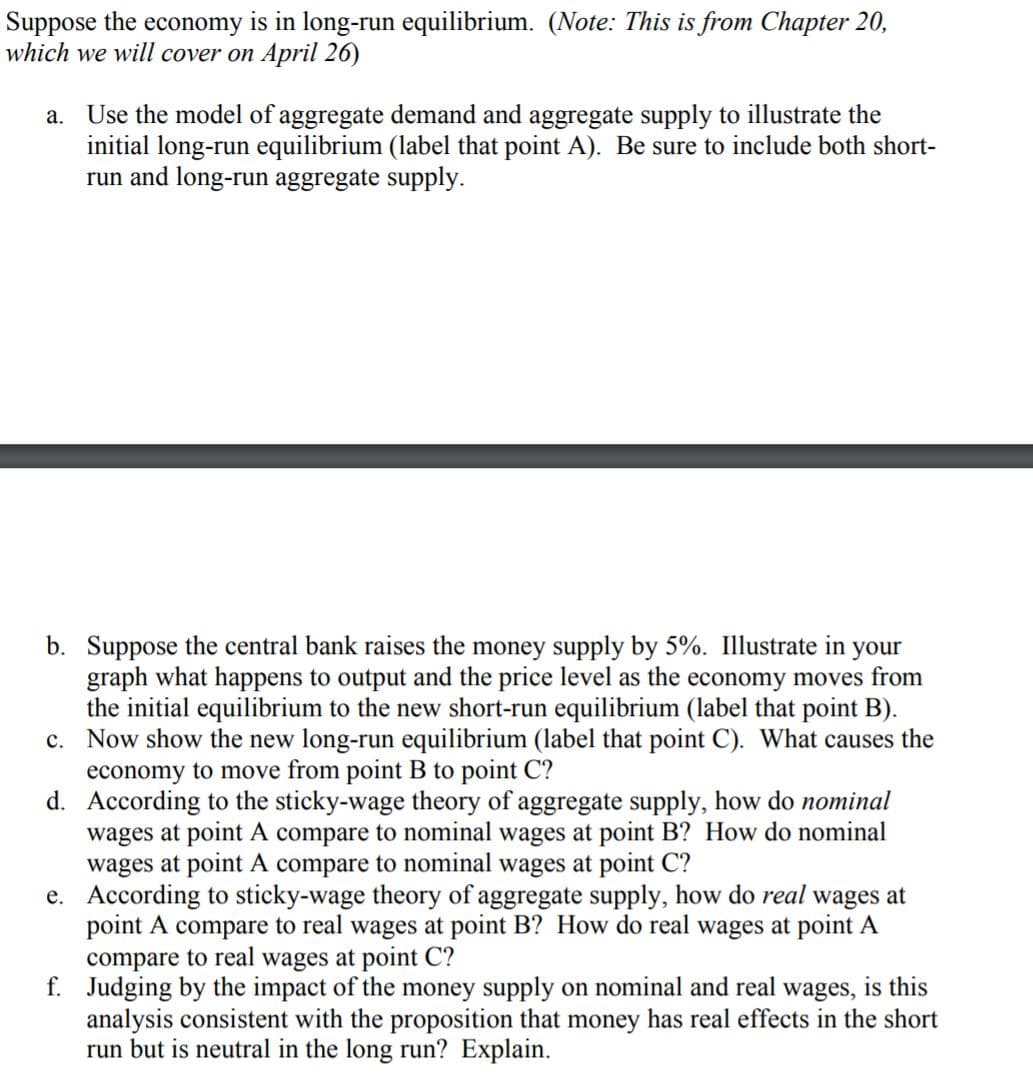d. According to the sticky-wage theory of aggregate supply, how do nominal wages at point A compare to nominal wages at point B? How do nominal wages at point A compare to nominal wages at point C?
d. According to the sticky-wage theory of aggregate supply, how do nominal wages at point A compare to nominal wages at point B? How do nominal wages at point A compare to nominal wages at point C?
Principles of Economics (MindTap Course List)
8th Edition
ISBN:9781305585126
Author:N. Gregory Mankiw
Publisher:N. Gregory Mankiw
Chapter33: Aggregate Demand And Aggregate Supply
Section: Chapter Questions
Problem 3PA
Related questions
Question
part d

Transcribed Image Text:Suppose the economy is in long-run equilibrium. (Note: This is from Chapter 20,
which we will cover on April 26)
a. Use the model of aggregate demand and aggregate supply to illustrate the
initial long-run equilibrium (label that point A). Be sure to include both short-
run and long-run aggregate supply.
b. Suppose the central bank raises the money supply by 5%. Illustrate in your
graph what happens to output and the price level as the economy moves from
the initial equilibrium to the new short-run equilibrium (label that point B).
c. Now show the new long-run equilibrium (label that point C). What causes the
economy to move from point B to point C?
d. According to the sticky-wage theory of aggregate supply, how do nominal
wages at point A compare to nominal wages at point B? How do nominal
wages at point A compare to nominal wages at point C?
e. According to sticky-wage theory of aggregate supply, how do real wages at
point A compare to real wages at point B? How do real wages at point A
compare to real wages at point C?
f. Judging by the impact of the money supply on nominal and real wages, is this
analysis consistent with the proposition that money has real effects in the short
run but is neutral in the long run? Explain.
Expert Solution
This question has been solved!
Explore an expertly crafted, step-by-step solution for a thorough understanding of key concepts.
Step by step
Solved in 2 steps

Knowledge Booster
Learn more about
Need a deep-dive on the concept behind this application? Look no further. Learn more about this topic, economics and related others by exploring similar questions and additional content below.Recommended textbooks for you

Principles of Economics (MindTap Course List)
Economics
ISBN:
9781305585126
Author:
N. Gregory Mankiw
Publisher:
Cengage Learning

Principles of Economics, 7th Edition (MindTap Cou…
Economics
ISBN:
9781285165875
Author:
N. Gregory Mankiw
Publisher:
Cengage Learning

Essentials of Economics (MindTap Course List)
Economics
ISBN:
9781337091992
Author:
N. Gregory Mankiw
Publisher:
Cengage Learning

Principles of Economics (MindTap Course List)
Economics
ISBN:
9781305585126
Author:
N. Gregory Mankiw
Publisher:
Cengage Learning

Principles of Economics, 7th Edition (MindTap Cou…
Economics
ISBN:
9781285165875
Author:
N. Gregory Mankiw
Publisher:
Cengage Learning

Essentials of Economics (MindTap Course List)
Economics
ISBN:
9781337091992
Author:
N. Gregory Mankiw
Publisher:
Cengage Learning

Brief Principles of Macroeconomics (MindTap Cours…
Economics
ISBN:
9781337091985
Author:
N. Gregory Mankiw
Publisher:
Cengage Learning

Principles of Economics 2e
Economics
ISBN:
9781947172364
Author:
Steven A. Greenlaw; David Shapiro
Publisher:
OpenStax
